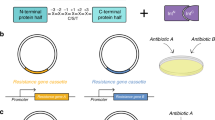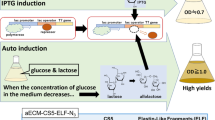Abstract
We have designed an advanced δ–integration system (integration of genes into the δ–sequence of yeast retrotransposon Ty) and used it for secretion of human nerve growth factor (hNGF) from Saccharomyces cerevisiae. The expression and secretion of hNGF was directed by the PGK promoter and MFα1 prepro–signal. Using two selectable markers (URA3 and leu2–d), haploid yeast strains were constructed with approximately 20 copies of a δ–integrated hNGF expression cassette on four chromosomes. The strain secreted hNGF at levels 3–4 fold higher than a 2μm–based plasmid. Northern and Western analyses revealed that the oversecretion was caused by an increased amount of mRNA. We also detected an unusual processing of the MFα1 prepro–hNGF fusion protein that required the pep4 mutation. Application of this system for industrial purposes is discussed.
This is a preview of subscription content, access via your institution
Access options
Subscribe to this journal
Receive 12 print issues and online access
$209.00 per year
only $17.42 per issue
Buy this article
- Purchase on Springer Link
- Instant access to full article PDF
Prices may be subject to local taxes which are calculated during checkout
Similar content being viewed by others
References
Smith, R.A., Duncan, M.J. and Moir, D.J. 1985. Heterologous protein secretion from yeast. Science 229: 1219–1224.
Sakai, A., Shimizu, Y. and Hishinuma, F. 1988. Isolation and characterization of mutants which show an oversecretion phenotype in Saccharomyces cerevisiae. Genetics 119: 499–506.
Suzuki, K., Ichikawa, K. and Jigami, Y. 1989. Yeast mutants with enhanced ability to secrete human lysozyme: isolation and identification of a protease-deficient mutant. Mol. Gen. Genet. 219: 58–64.
Bitter, G.A., Egan, K.M., Koski, E.R., Jones, M.D., Elliott, S.G. and Giffin, J.C. 1987. Expression and secretion vectors for yeast. Methods Enzymol. 153: 516–544.
Sakai, A., Shimizu, Y. and Hishinuma, F. 1990. Integration of heterologous genes into the chromosome of Saccharomyces cerevisiae using a delta sequence of yeast retrotransposon Ty. Appl. Microbiol. Biotechnol. 33: 302–306.
Kanaya, E., Higashizaki, T., Ozawa, F., Hirai, K., Nishizawa, M., Tokunaga, M., Tsukui, H., Hatanaka, H. and Hishinuma, F. 1989. Synthesis and secretion of human nerve growth factor by Saccharomyces cerevisiae. Gene 83: 65–74.
Julius, D., Brake, A., Blair, L., Kunisawa, R. and Thorner, J. 1984. Isolation of the putative structural gene for the lysine-arginine-cleaving endopeptidase required for processing of yeast prepro-α-factor. Cell 37: 1075–1089.
Julius, D., Schekman, R. and Thorner, J. 1984. Glycosylation and processing of prepro-α-factor through the yeast secretory pathway. Cell 36: 309–318.
Lehle, L., Cohen, R.E. and Ballou, C.E. 1979. Carbohydrate structure of yeast invertase: demonstration of a form with only core oligosaccharides and a form with completed polysaccharide chains. J. Biol. Chem. 254: 12209–12218.
Errede, B., Company, M. and Hutchinson, III. 1987. Ty1 sequence with enhancer and mating-type-dependent regulatory activities. Mol. Cell Biol. 7: 258–265.
Company, M. and Errede, B. 1987. Cell-type-dependent gene activation by yeast transposon Ty1 involves multiple regulatory determinants. Mol. Cell Biol. 7: 3205–3211.
Strathern, J.N., Newlon, C.S., Herskowitz, I. and Hicks, J.B. 1979. Isolation of a circular derivative of yeast chromosome III: implication for the mechanism of mating type interconversion. Cell 18: 309–319.
Schekman, R. and Novick, P. 1982. The secretory process and yeast cell-surface assembly, p. 361–393. In: The Molecular Biology of The Yeast Saccharomyces. Metabolism And Gene Expression. Strathern, J. N., Jones, E. W. and Broach, J. R. (Eds). Cold Spring Harbor Laboratory, Cold Spring Harbor, N.Y.
Sherman, F., Fink, G.R. and Hicks, J.B. 1986. Laboratory Manual for Methods in Yeast Genetics. Cold Spring Harbor Laboratory, Cold Spring Harbor, N.Y.
Maniatis, T., Fritsch, E.F. and Sambrook, J. 1982. Molecular Cloning: A Laboratory Manual. Cold Spring Harbor Laboratory, Cold Spring Harbor, N.Y.
Hanahan, D. 1983. Studies on transformation of Escherichia coli with plasmids. J. Mol. Biol. 166: 557–580.
Ito, H., Fukuda, Y., Murata, K. and Kimura, A. 1983. Transformation of intact yeast cells treated with alkali cations. J. Bacteriol. 153: 163–168.
Tokunaga, M., Wada, N. and Hishinuma, F. 1987. A novel yeast secretion vector utilizing secretion signal of killer toxin encoded on the yeast linear DNA plasmid pGKL1. Biochem. Biophys. Res. Com. 144: 613–619.
Eckerskorn, C., Mewes, W., Goretzki, H. and Lottspeich 1988. A new siliconized-glass fiber as support for protein-chemical analysis of electroblotted proteins. Eur. J. Biochem. 176: 509–519.
Carle, G.F. and Olson, M.V. 1985. An electrophoretic karyotype for yeast. Proc. Natl. Acad. Sci. USA 82: 3756–3760.
Chu, G., Vollrath, D. and Davis, R.W. 1986. Separation of large DNA molecules by contour-clamped homogeneous electric fields. Science 234: 1582–1585.
Erhart, E. and Hollenberg, C.P. 1983. The presence of a defective LEU2 gene on 2μ DNA recombinant plasmids of Saccharomyces cerevisiae is responsible for curing and high copy number. J. Bacteriol. 156: 625–635.
Woolford, C.A., Daniels, L.B., Park, F.J., Jones, E.W., Van Arsdell, J.N. and Innis, M.A. 1986. The PEP4 gene encodes an aspartyl protease implicated in the posttranslational regulation of Saccharomyces cerevisiae vacuolar hydrolases. Mol. Cell. Biol. 6: 2500–2510.
Author information
Authors and Affiliations
Rights and permissions
About this article
Cite this article
Sakai, A., Ozawa, F., Higashizaki, T. et al. Enhanced Secretion of Human Nerve Growth Factor from Saccharomyces cerevisiae using an Advanced δ–Integration System. Nat Biotechnol 9, 1382–1385 (1991). https://doi.org/10.1038/nbt1291-1382
Received:
Accepted:
Issue Date:
DOI: https://doi.org/10.1038/nbt1291-1382
This article is cited by
-
Gene copy number and polyploidy on products formation in yeast
Applied Microbiology and Biotechnology (2010)
-
Multiple-copy integration in the yeast Yarrowia lipolytica
Current Genetics (1994)
-
Biologically active human and mouse nerve growth factors secreted by the yeast Saccharomyces cerevisiae
Applied Microbiology and Biotechnology (1993)
-
Integration of repeated sequences (pBR322) in the Bacillus subtilis 168 chromosome without affecting the genome structure
Molecular and General Genetics MGG (1993)



